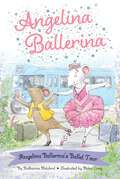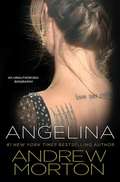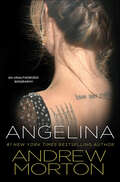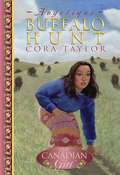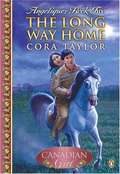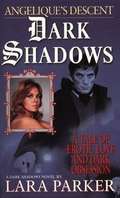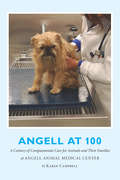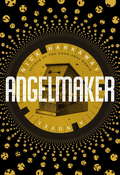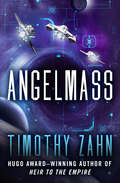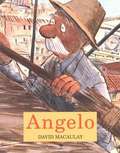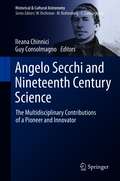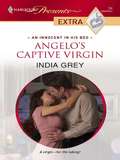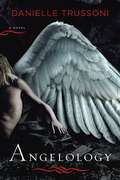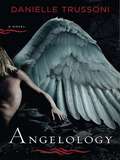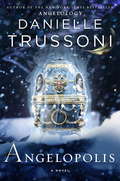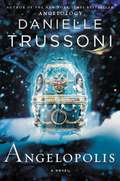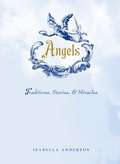- Table View
- List View
Angelina Ballerina's Ballet Tour (Angelina Ballerina)
by Katharine HolabirdAngelina Ballerina goes on a tour like a real ballerina in this chapter book featuring an all-new, original Angelina Ballerina story and black-and-white illustrations throughout!Angelina and the other little dancers at Miss Lilly&’s Ballet School are going on a ballet tour! They are traveling to towns near Chipping Cheddar to perform. Angelina is excited but also nervous. Will she still dance her best when she isn&’t on her home stage? This charming chapter book is perfect for Angelina Ballerina fans beginning to read on their own or for reading aloud! © 2023 Helen Craig Ltd and Katharine Holabird. The Angelina Ballerina name and character and the dancing Angelina logo are trademarks of HIT Entertainment Limited, Katharine Holabird, and Helen Craig.
Angelina and Alice
by Katharine HolabirdAngelina loves to do gymnastics with her new friend Alice. But when Angelina can't do a handstand, all the older children laugh at her, and Alice joins in. By the end of the story, Angelina and Alice learn the importance of teamwork and become the best of friends all over again.
Angelina's Bachelors
by Brian O'ReillySometimes the shortest distance between two people is the length of a kitchen table. . . . Far too young to be a widow, Angelina D'Angelo suddenly finds herself facing a life without her beloved husband, Frank. Late one night shortly after the funeral, she makes her way down to the kitchen and pours all of her grief and anger into the only outlet she has left--her passion for cooking. In a frenzy of concentration and swift precision, she builds layer upon layer of thick, rich lasagna, braids loaves of yeasty bread, roasts plump herb-rubbed chicken; she makes so much food that she winds up delivering the spoils to the neighbors in her tight-knit Italian community in South Philadelphia. Retiree Basil Cupertino, who has just moved in with his kindly sister across the street, is positively smitten with Angelina's food. In a stroke of good fortune, Basil offers Angelina (not only husbandless but unemployed) a job cooking for him--two meals a day, six days a week, in exchange for a handsome salary. Soon, word of her irresistible culinary prowess spreads and she finds herself cooking for seven bachelors--and in the process discovers the magical power of food to heal, to bring people together . . . and maybe even to provide a second chance at love. Filled to the brim with homemade warmth, Angelina's Bachelors is a sweet tale of overcoming grief, redefining family, and following your heart--through food.
Angelina's Birthday Surprise
by Katharine HolabirdWhat will Angelina Ballerina get for a special birthday surprise? A new pair of ballet slippers? Not quite.
Angelina: An Unauthorized Biography
by Andrew Morton#1 "New York Times"-bestselling biographer Morton paints a mesmerizing portrait of the secret history and private life of gorgeous, exotic, and mysterious icon Angelina Jolie. This biography describes the actress's childhood, battle with drugs, 2 marriages, acting/modeling career, relationship with actor Brad Pitt, and the adoptions and births of her 6 children.
Angelina: An Unauthorized Biography
by Andrew MortonThe gripping true story of Angelina Jolie, from #1 New York Times bestselling biographer Andrew Morton."I like to collect knives," says Angelina Jolie, "but I also collect first edition books." At first glance, she might seem to be someone without any secrets, talking openly about her love life, sexual preferences, drug use, cutting, and tattoos--and why she kissed her brother on the lips in public. And yet mysteries remain: What was really going on in her brief, impulsive marriages to Jonny Lee Miller and Billy Bob Thornton, and what was going on in her partnership with Brad Pitt? What's behind the oft-reported feud with her father, the Oscar-winning actor Jon Voight? What drove her to become a mother of six children in six years? And—perhaps most puzzling of all—what about the other side of Angelina: How did this talented but troubled young actress, barely 35 years old, become a respected Goodwill Ambassador for the United Nations as well as the "most powerful celebrity in the world" (unseating Oprah Winfrey) on Forbes' 2009 Celebrity 100 list? The answers that Andrew Morton has uncovered are astonishing, taking us deep inside Angelina's world to show us what shaped her as a child, as an actress, and as a woman struggling to overcome personal demons that have never before been revealed. In this spellbinding biography, Andrew Morton draws upon far-reaching original interviews and research, accompanied by exclusive private photographs, to show us the true story behind both the wild excesses of Angelina's youth and her remarkable work with children and victims of poverty and disaster today.
Angelique #1: Buffalo Hunt (Our Canadian Girl)
by Cora TaylorBuffalo Hunt is set in the West, during the waning years of the buffalo hunt. Angelique Dumas is a ten-year-old Métis girl, and this year she gets to be part of the hunt-- not with the children, but with the grown-ups.
Angelique #2: The Long Way Home (Our Canadian Girl)
by Cora TaylorAngelique, along with her brother, Joseph, and friend François, is determined to bring their beloved horses home, even if she has to take on the raiders herself!
Angelique's Descent (Dark Shadows)
by Lara Parker... The dashing heir of a New England shipping magnate Barnabas Collins captured the heart of the exquisite, young Angelique amidst the sensual beauty of Martinique, her island home. But Angelique's brief happiness is doomed when Barnabas cruelly deserts her and becomes engaged to another. Little, though, does Barnabas know of the evil his betrayal will unleash. . . . AND DESTROYED BY Jealousy AND BETRAYAL For Angelique is no ordinary woman. Raised in the mysterious black art of voodoo witchcraft, she had long ago pledged her soul to darkness and become immortal. vowing to torment and destroy Barnabas, a vengeful Angelique damns him to eternal life as a vampire--a companion to accompany her forever. Little, though, does Angelique understand the depth of Barnabas's fury. . .
Angell at 100: A Century of Compassionate Care for Animals and Their Families at Angell Animal Medical Center
by Karen CampbellAngell at 100: A Century of Compassionate Care for Animals and Their Families at Angell Animal Medical Center chronicles the achievements of one of the foremost clinical veterinary institutions in the world. Angell Animal Medical Center is the first and largest animal hospital in New England. This book is a celebration of one hundred years of groundbreaking innovation and heartfelt compassion. Founded in 1868 by George Angell, the MSPCA is the second oldest humane organization in America. Its flagship hospital, Angell Animal Medical Center, was founded in 1915, and was the first animal hospital in New England. The MSPCA Angell has expanded from advocacy and protection to healing and advancing the practice of veterinary medicine. Over the past century the organization has seen vast changes in society, the environment, and the attitude to the animals in our lives. It has helped make laws and set standards that have fundamentally shaped our sense of kindness and care for animals and for one another. In the 21st century, MSPCAAngell continues to rescue, shelter, protect, heal, and advocate for animals, giving special care to tens of thousands of animals each year. It also provides emergency assistance and strategic planning help for animal protection groups across the United States and around the globe. This book is a portrait of Angell Animal Medical Center from its founding in 1915 to the present day, and tells the stories of the dedicated doctors, the creative medical innovations, and of course the tales of the diverse patients and their families. Today the hospital has specialties ranging from acupuncture to ophthalmology, from behavioral services to nutrition, from dentistry to neurology and neurosurgery, as well as general medicine. Although the majority of the patients are dogs and cats, birds and rabbits are not uncommon, and there is sometimes even the occasional tortoise.
Angell, Pearl and Little God
by Winston GrahamThe lives of a London solicitor, a beautiful shop girl and a prize-fighter become bound together by greed and lust. Over this relationship hangs an atmosphere of violence that erupts into murder.
Angelmaker
by Nick HarkawayFrom the acclaimed author of The Gone-Away World, blistering gangster noir meets howling absurdist comedy as the forces of good square off against the forces of evil, and only an unassuming clockwork repairman and an octogenarian former superspy can save the world from total destruction. Joe Spork spends his days fixing antique clocks. The son of infamous London criminal Mathew "Tommy Gun" Spork, he has turned his back on his family's mobster history and aims to live a quiet life. That orderly existence is suddenly upended when Joe activates a particularly unusual clockwork mechanism. His client, Edie Banister, is more than the kindly old lady she appears to be--she's a retired international secret agent. And the device? It's a 1950s doomsday machine. Having triggered it, Joe now faces the wrath of both the British government and a diabolical South Asian dictator who is also Edie's old arch-nemesis. On the upside, Joe's got a girl: a bold receptionist named Polly whose smarts, savvy and sex appeal may be just what he needs. With Joe's once-quiet world suddenly overrun by mad monks, psychopathic serial killers, scientific geniuses and threats to the future of conscious life in the universe, he realizes that the only way to survive is to muster the courage to fight, help Edie complete a mission she abandoned years ago and pick up his father's old gun . . .
Angelmass
by Timothy Zahn“Fast-paced action . . . first-rate sf space adventure” (Library Journal) from the #1 New York Times–bestselling author of Star Wars: Thrawn. Deep in space lies the black hole known as Angelmass, so called because it emits enigmatic particles with the unusual ability to render humans calm, reasonable, and incapable of lying—which would normally be seen as a good thing. But not by everyone. For while Empyrean human colonies on the edge of the galaxy utilize the power of the “angels,” the Earth-based Pax empire views the emissions as a threat that could be used to subvert humanity. Academic Jereko Kosta is pressed into service by the Pax to spy on the Empyrean, joining the crew of a ship actively hunting the particles. But what he learns turns out to be both scientifically fascinating and morally frightening. When the Pax make an aggressive move that may lead to all-out war with the Empyrean, Kosta is the only one who can stop the conflict between the human powers and force them to see that the angels they’re about to fight over are far from holy . . . Timothy Zahn combines provocative ethical questions with the same level of vivid sci-fi action that made his Star Wars: Thrawn a New York Times bestseller to deliver “a serious SF novel sneakily posing as an enormous golden-age thrill ride” (Locus).
Angelo
by David MacaulayHigh above the rooftops of Rome, Angelo begins his work restoring the façade of a once glorious church. As with every project, he starts his final masterpiece by clearing away the years of debris left behind by the many pigeons who nest in the nooks and crannies of Rome’s great architecture. There, among the sticks and feathers, he discovers a wounded bird. Finding no safe place to leave her, Angelo becomes the bird’s reluctant savior. As the church nears completion, Angelo begins to worry about the future of his aviary friend. "What will become of you? Where will you go . . . where will you . . . live?” he asks her. Realizing what he must do, Angelo returns to the church to add one final finishing touch. Through his artistry as a master craftsman he answers the questions about his humble friend and assures that he will not be forgotten. With his expressive illustrations, filled with detail and humor and infused with the warm, terra-cotta glow of the Mediterranean, David Macaulay will once again capture his readers’ hearts and imaginations with this poignant story of enduring friendship.
Angelo Secchi and Nineteenth Century Science: The Multidisciplinary Contributions of a Pioneer and Innovator (Historical & Cultural Astronomy)
by Guy Consolmagno Ileana ChinniciAngelo Secchi was a key figure in 19th century science. An Italian Jesuit and scientist, he helped lead the transition from astronomy to astrophysics and left a lasting legacy in the field. Secchi’s spectral classification of stars was a milestone that paved the way for modern astronomical research. He was also a founder of modern meteorology and an innovator in the design and development of new instruments and methods across disciplines.This contributed volume collects together reviews from an international group of historians, scientists and scholars representing the multiple disciplines where Secchi made significant contributions during his remarkable career. It analyzes both his famous and lesser known pioneering efforts with equal vigor, providing a well-rounded narrative of his life’s work. Beyond his scientific and technological work, his role as a Jesuit priest in Rome during the turbulent years of the mid 19th century is also described and placed in the context of his scientific and civic activities.
Angelo Zottoli, a Jesuit Missionary in China: His Life and Ideas (Christianity in Modern China)
by Antonio De CaroThis book offers a study of the cosmogonic works by Fr. Angelo Zottoli S.J., a Jesuit missionary who has received relatively little attention by modern scholars, but who deserves a special recognition for his theological and philosophical ideas. More generally, the book aims to shed light on the importance of cosmogony in the cross-cultural and interdisciplinary environment of Xujiahui, the area in modern Shanghai where Zottoli flourished. It shows how through Zottoli’s teaching and sermons he was able to reimagine his own cosmogonic ideas, his personality, and his relationship with local Chinese converts. Among Zottoli’s most famous students was Ma Xiangbo (馬相伯 1840–1939) and Zottoli played a crucial role in Ma’s intellectual formation.A wider familiarity with Zottoli’s works is not only interesting in and of itself, but also paves the way to future studies on the complex and multifaceted relationship between European missionaries and Chinese students in Shanghai during the nineteenth century.
Angelo's Captive Virgin
by India GreyItalian tycoon Angelo Emiliani wants to buy Anna's French château, but it seems she'll do anything to stop him. So he'll take Anna captive on his yacht, and show her he's not to be toyed with. But as cabin fever sets in, passions erupt, and Anna realizes the price of stopping Angelo has just gotten higher. Now there's more at stake than saving the château--Anna's at risk of losing her virginity, and more!
Angelology
by Danielle TrussoniA thrilling epic about an ancient clash reignited in our time--between a hidden society and heaven's darkest creatures. There were giants in the earth in those days; and also after that, when the sons of God came in unto the daughters of men, and they bore children to them. Genesis 6:5. Sister Evangeline was just a girl when her father entrusted her to the Franciscan Sisters of Perpetual Adoration in upstate New York. Now, at twenty-three, her discovery of a 1943 letter from the famous philanthropist Abigail Rockefeller to the late mother superior of Saint Rose Convent plunges Evangeline into a secret history that stretches back a thousand years: an ancient conflict between the Society of Angelologists and the monstrously beautiful descendants of angels and humans, the Nephilim. For the secrets these letters guard are desperately coveted by the once-powerful Nephilim, who aim to perpetuate war, subvert the good in humanity, and dominate mankind. Generations of angelologists have devoted their lives to stopping them, and their shared mission, which Evangeline has long been destined to join, reaches from her bucolic abbey on the Hudson to the apex of insular wealth in New York, to the Montparnasse cemetery in Paris and the mountains of Bulgaria. Rich in history, full of mesmerizing characters, and wondrously conceived, Angelology blends biblical lore, the myth of Orpheus and the Miltonic visions of Paradise Lost into a riveting tale of ordinary people engaged in a battle that will determine the fate of the world.
Angelology: A Novel (Angelology Series #1)
by Danielle TrussoniThe Nephilim were on the earth in those days Genesis 6:4 When Sister Evangeline finds mysterious correspondence between Mother Innocenta of the Saint Rose Convent and legendary philanthropist Abigail Rockefeller, it confirms Angels walked among us – and their descendants, the cruel Nephilim, still do. Indeed, the Nephilim are hunting for artefacts concealed by Abigail Rockefeller during the Second World War - objects that will ultimately allow them to enslave mankind - and have so far been prevented from reaching their apocalyptic goal by one, clandestine organisation: The Angelology Society. And if the Angelologists are to stand any chance of winning this new battle in the ages-old war, they must find the artefacts first. But their fate rests in the hands of innocent Sister Evangeline, who holds the key to unlocking Abigail Rockefeller's hiding places … and whose own destiny may yet find her prey to the terrifying Nephilim army, with horrifying consequences for humanity.
Angelopolis
by Danielle TrussoniAn exquisite return to the "breathtakingly imaginative" (People) and seductive world of the New York Times bestseller Angelology. Hailed by USA Today as "a thrill ride best described as The Da Vinci Code meets Raiders of the Lost Ark," Danielle Trussoni's bestselling first novel, Angelology, wove biblical lore, the Orpheus myth, and Milton's Rebel Angels into a present-day world tinged with the divine supernatural. The novel plunged two endearing isolatoes -- art historian V. A. Verlaine and Evangeline, a beautiful young nun--into an ancient battle between a secret society and mankind's most insidious enemies: angel-human hybrids known as the Nephilim. Now a decade has passed since Verlaine saw Evangeline alight from the Brooklyn Bridge, the sight of her wings a betrayal that haunts him still. The Nephilim are again on the rise, scheming to construct their own paradise -- the Angelopolis -- and ruthlessly pursued by Verlaine in his new calling as an angel hunter. But when Evangeline materializes, Verlaine is besieged by doubts that will only grow as forces more powerful than even the Nephilim draw them from Paris to St. Petersburg and deep into the provinces of Siberia and the Black Sea coast. A high-octane tale of abduction and liberation, treasure seeking and divine warfare, Angelopolis plumbs Russia's imperial past, modern genetics, and the archangel Gabriel's famous visitations to conceive a fresh tableau of history and myth that will, once again, enthrall readers the world over.
Angelopolis
by Danielle Trussoni"A stunning follow-up to the best-seller Angelology. . . Part historical novel, fantasy, love story, thriller, and mystery. . . It's a must-read." --Booklist (starred review) A New York Times bestseller and global sensation, Angelology unfurled a brilliant tapestry of myth and biblical lore on our present-day world and plunged two star-crossed heroes into an ancient battle against mankind's greatest enemy: the fatally attractive angel-human hybrids known as the Nephilim. With Angelopolis, the conflict deepens into an inferno of danger and passion unbound. A decade has passed since Verlaine saw Evangeline alight from the Brooklyn Bridge, the sight of her new wings a betrayal that haunts him still. Now an elite angel hunter for the Society of Angelology, he pursues his mission with single-minded devotion: to capture, imprison, and eliminate her kind. But when Evangeline suddenly appears on a twilit Paris street, Verlaine finds her nature to be unlike any of the other creatures he so mercilessly pursues, casting him into a spiral of doubt and confusion that only grows when she is abducted before his eyes by a creature who has topped the society's most-wanted list for more than a century. The ensuing chase drives Verlaine and his fellow angelologists from the shadows of the Eiffel Tower to the palaces of St. Petersburg and deep into the provinces of Siberia and the Black Sea coast, where the truth of Evangeline's origins--as well as forces that could restore or annihilate them all--lie in wait. Conceived against an astonishing fresh tableau of history and science, Angelopolis plumbs Russia's imperial past, modern genetics, and ancient depictions of that most potent angelic appearance--the Annunciation of Gabriel--in a high-octane tale of abduction, treasure seeking, and divine warfare as the fate of humanity once again hangs in the balance.
Angelopolis: A Novel
by Danielle Trussoni"A stunning follow-up to the best-seller Angelology. . . Part historical novel, fantasy, love story, thriller, and mystery. . . It's a must-read."--Booklist (starred review) A New York Times bestseller and global sensation, Angelology unfurled a brilliant tapestry of myth and biblical lore on our present-day world and plunged two star-crossed heroes into an ancient battle against mankind's greatest enemy: the fatally attractive angel-human hybrids known as the Nephilim. With Angelopolis, the conflict deepens into an inferno of danger and passion unbound.A decade has passed since Verlaine saw Evangeline alight from the Brooklyn Bridge, the sight of her new wings a betrayal that haunts him still. Now an elite angel hunter for the Society of Angelology, he pursues his mission with single-minded devotion: to capture, imprison, and eliminate her kind.But when Evangeline suddenly appears on a twilit Paris street, Verlaine finds her nature to be unlike any of the other creatures he so mercilessly pursues, casting him into a spiral of doubt and confusion that only grows when she is abducted before his eyes by a creature who has topped the society's most-wanted list for more than a century. The ensuing chase drives Verlaine and his fellow angelologists from the shadows of the Eiffel Tower to the palaces of St. Petersburg and deep into the provinces of Siberia and the Black Sea coast, where the truth of Evangeline's origins--as well as forces that could restore or annihilate them all--lie in wait.Conceived against an astonishing fresh tableau of history and science, Angelopolis plumbs Russia's imperial past, modern genetics, and ancient depictions of that most potent angelic appearance--the Annunciation of Gabriel--in a high-octane tale of abduction, treasure seeking, and divine warfare as the fate of humanity once again hangs in the balance.
Angels
by Alexis York LumbardDid you know that angels of all kinds are everywhere? &“Some are big, some are tiny. They're all so bright and very shiny.&” This lyrical, breezy, and nondenominational picture book introduces children and adults to a magical place which radiates warmth, love, and caring throughout its colorful and delicate pages. With its rich paintings, readers are transported through many colorful scenes, places and seasons to see how angels work behind the scenes, weaving their graces throughout the world.Through Angels, readers can experience a world of gentle wonder, beauty, and comfort that makes this a perfect bedtime story. &“Angels, angels, always near, protecting you, my special dear!&”
Angels
by Isabella AndersonA Heavenly Treasury of Angelic Lore!Every culture cherishes a winged spirit--from the ancient Egyptian ka and Norse Valkyries to Hindu apsaras and the archangels of the Bible. Featuring biblical tales, poetry, and lovely illustrations, this collection reveals the divine powers of angels, the history behind their existence, and the many ways you can include them in your life.For centuries, angels have served as messengers, warriors, and guardians who have a special bond with humans. Angels can help you release worry and guilt, heal physically and emotionally, and manifest your dreams. All you need to do is open yourself up to receive divine messages and insight. You'll discover the magic of signs, synchronicities, and coincidences and learn how to interpret their meaning as messages from angels.From the frightening cherubim guarding the entrance to the Garden of Eden with their flaming swords to the ethereal angels of the Renaissance, this collection is sure to captivate anyone interested in exploring the varied history, culture, and ideas of mysterious celestial beings.
